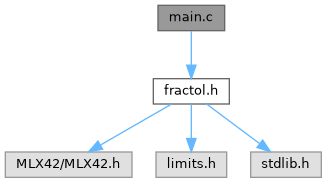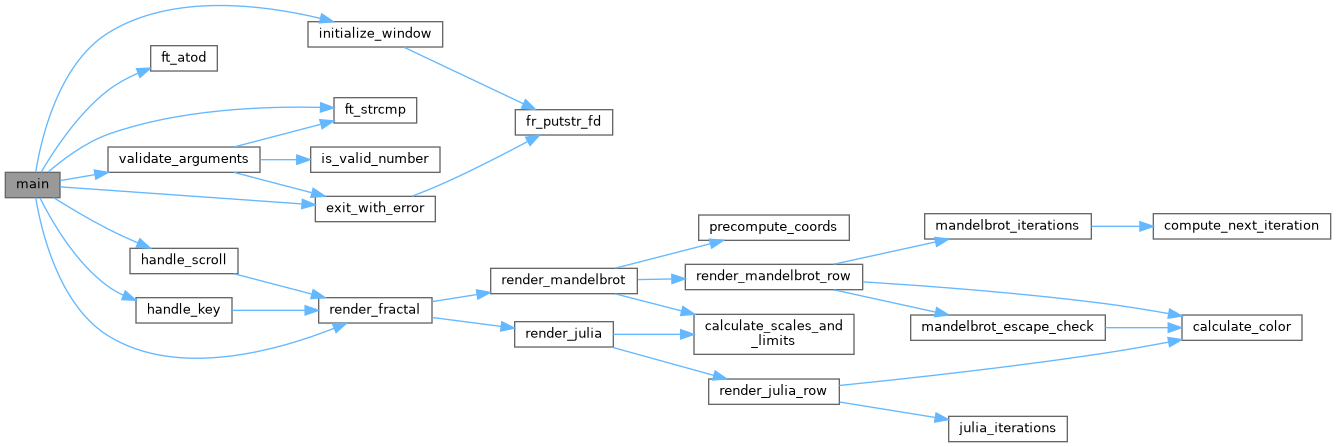Entry point for the Fractol application. More...
#include "fractol.h"
Go to the source code of this file.
Functions | |
| static int | is_valid_number (const char *str) |
| Validates if a string represents a valid number. | |
| static void | exit_with_error (const char *message, char *argv[]) |
| Prints an error message and terminates the program. | |
| static void | validate_arguments (int argc, char *argv[]) |
| Validates the command-line arguments for fractal rendering. | |
| static void | initialize_window (t_data *data, char *argv[]) |
| Initializes the MLX42 rendering environment. | |
| int | main (int argc, char *argv[]) |
| Main entry point for the fractal rendering program. | |
Detailed Description
Entry point for the Fractol application.
This file contains the main function and orchestrates the entire fractal rendering process. It handles:
- Command-line argument validation to ensure correct input.
- Initialization of the fractal type and parameters (Julia or Mandelbrot)
- Setuup of the rendering environment using the MLX42 graphics liibrary, including the creation of the window and image bufffer.
- Fractal rendering based on the user-specified parameters.
- Configuration of interactivee event hooks for keyboard and scroll inputs.
- Continuous updates through the main event loop.
The program terminates gracefully on completion or reports error for invalid inputs.
Definition in file main.c.
Function Documentation
◆ exit_with_error()
|
static |
Prints an error message and terminates the program.
This function displays an error, the correct usage off the program, and list of available fractal types with examples. It then terminates the program with a failure status.
- Parameters
-
message Error message to display. argv Command-line arguments, used to show the program name in usage examples.
Definition at line 87 of file main.c.


◆ initialize_window()
|
static |
Initializes the MLX42 rendering environment.
This function sets up the environment for rendering fractals by:
- Creating an MLX42 window with thee given title.
- Allocating an image buffer for rendering.
- Setting initial offsets and zoom level for the fractal.
If Julia set parameters (c[COMPLEX_RE] or c[COMPLEX_IM]) are outside the range [-2.0, 2.0], it issues a warning about potential visual effects. The function terminates the program in case of initialization failures.
- Parameters
-
data Pointer to the data structure containing fractal information, offsets, zoom, and MLX42 resources. argv Array of argument strings, where argv[1] is used as the window title.
Definition at line 167 of file main.c.


◆ is_valid_number()
|
static |
Validates if a string represents a valid number.
This function checks iff the input string is a valid number, considering:
- Optional leading spaces or tabs.
- An optional sign (+/-).
- At least one digit.
- At most one decimal point with digits before or after it. Invalid cases include multiple decimal points, invalid characters, or empty strings.
- Parameters
-
str Input string to validate
- Returns
- 1 if the string is a valid number, 0 otherwise.
Definition at line 47 of file main.c.

◆ main()
| int main | ( | int | argc, |
| char * | argv[] | ||
| ) |
Main entry point for the fractal rendering program.
This function orchestrates the entire fractal rendering process by:
- Validating the command-line arguments to ensure correct fractal type and parameters.
- Initializing the fractal type, including Julia parameters if applicable.
- Setting up the MLX42 rendering environment, including the window and image buffer.
- Rendering the chosen fractal based on the input parameters.
- Configuring event hooks for used interaction (keyboard and scroll events).
- Starting the main event loop for continuous interaction and updates.
- Parameters
-
argc Number of arguments passed to the program. argv Array of argument strings, including the program name and input parameters.
- Returns
- Returns
EXIT_SUCCESSon successful execution, or terminates on error.
Definition at line 215 of file main.c.

◆ validate_arguments()
|
static |
Validates the command-line arguments for fractal rendering.
This function checks that the user has specified a valid fractal type and the correct parameters. The supported fractals and their requirements are:
mandelbrot: No additional arguments.julia: Requires exactly two valid numbers representing the real and imaginary part of the parameter.
If the arguments are invalid, the function calls exit_with_error() to display an appropiate error message and terminate the program.
- Parameters
-
argc Number of command-line arguments passed to the program. argv Array of command-line argument strings.
Definition at line 122 of file main.c.

